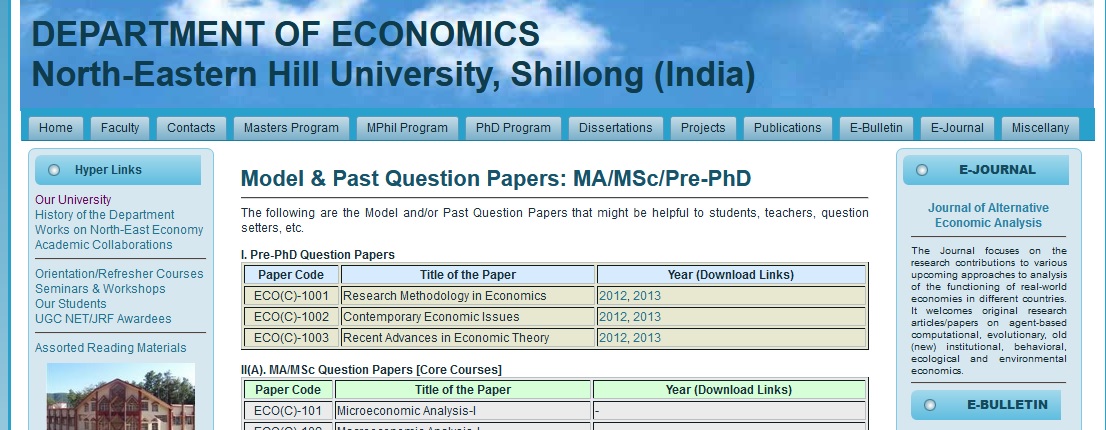nehu-economics.info : Historical Perspective of Modern Economics-II Question Paper
Name of the Organisation : Department Of Economics,North-Eastern Hill University, Shillong
Exam : MA/MSc Question Papers
Subject : Historical Perspective of Modern Economics-II
Year : 2013
Document Type : Model & Past Question Papers
Website : https://www.nehu.ac.in/
Download Model/Sample Question Paper :
Historical Perspective 2011 : https://www.pdfquestion.in/uploads/13332-Hiseco11.pdf
Historical Perspective 2012 : https://www.pdfquestion.in/uploads/13332-Hiseco12.pdf
Historical Perspective 2013 : https://www.pdfquestion.in/uploads/13332-Hiseco13.pdf
Historical Perspective of Modern Economics-II Question Paper
Full Marks: 37.5;
Time: 1.30 hours
** Figures in the margin indicate full marks for the questions
** Answer two and half questions, selecting at least one from each Credit.
Related : North-Eastern Hill University MA/MSc Industrial Economics Question Paper : www.pdfquestion.in/13329.html
CREDIT-I :
1. Describe the relationship among (i) imperfect knowledge, (ii) transaction costs and (iii) bounded rationality. 15
2. (a). Discuss the principal-agent problem. 7.5
(b). Discuss the concept of satisficing behaviour. 7.5
CREDIT-II :
3. How do institutions emerge and evolve? In this context, discuss the process of habit formation. 10+5
4. (a). Discuss the salient features of evolutionary economics. 7.5
(b). Discuss the nature and relevance of the agent-based computational economics. 7.5

Historical Perspective of Modern Economics-II 2012 :
Full Marks: 75
Time : Three hours
** The figure in the margin indicate full marks for the questions
** Answer any five questions, taking at least one from each unit
CREDIT – I :
1. Discuss the organizational types of firms on the basis of their ownership. Explain the major characteristics of Joint Stock Company. 7+8
2. What is the theoretical model of price determination of a firm? Examine the various principles of pricing practiced by the industrial firms. 5+10
CREDIT – II :
3. Analyse critically the main motives of product diversification. Differentiate among Lateral, Conglomerate, Diagonal and Vertical diversification. 7+8
4. What do you understand by market concentration? List the various measures of market concentration. How does market concentration influence the market performance of a firm? 5+5+5
CREDIT – III :
5. Discuss the application of ratio analysis in the interpretation of financial statement and in financial analysis. What are its limitations? 10+5
6. What is capital budgeting? Explain the method of calculating payback period and Net Present Value. What are the decision rules in the two methods? 3+8+4
CREDIT – IV :
7. Critically discuss the important measures introduced in the Industrial Policy of 1991. In what way do these policies mark a departure from the policies followed till this period. Has the new industrial policy been successful to make the Indianindustries competitive? 5+6+4
8. Write short notes on any two of the following: 71/2 x 2
(a) Problems of Small Scale Industries
(b) Disinvestment of Public Sector Units
(c) Industrial growth in post liberalization period
(d) Industrial sickness
Historical Perspective of Modern Economics-II 2011 :
Full Marks: 37.5
Time: 1.30 hours
Note :
** Figures in the margin indicate full marks for the questions
** Answer two and half questions, selecting at least one from each Credit
CREDIT-I :
1. While discussing the historical sciences, Theory of Growth of Scientific Knowledge plays an important role. Discuss the statement in the context of Kuhn’s theory. Also point out the flaws of this theory. 10+5
2. (a). When a lottery game (theoretical) leads to a random variable with infinite expected payoff, but could nevertheless be considered to be worth only a small amount of money, what would be the possible solution to this problem? Discuss with the help of St. Petersburg’s Paradox. 7.5
(b). Write a short note on satisficing behavior as propounded by H. Simon. 7.5
CREDIT-II :
3. The new growth theory revived an old tradition of thinking about the effects of increasing returns. Critically discuss the statement in the context of Paul Romer’s theory of Growth. 15
4. (a). Discuss how D.C. North modified the assumption of Neoclassical economics. 7.5
(b). Why economics is a complex academic system? 7.5
Environmental Economics 2012 :
Full Marks: 75
Time: 3 hours
Note :
** The Figures in the margin indicate full marks for the questions
** Answer Five questions, selecting at least one from each Credit
CREDIT – I :
1. Explain the concepts of Environment, Ecology and Ecosystem. What are the major components of Environmental Economics? (15+10)
2. What do you understand by sustainable development? Explain the indicators and measurements of sustainable development. (5+10)
CREDIT – II :
3. (a) Define market failure. Describe how market failure arises in case of negative externality.
(b) Define common property resource. Also, show that if the property is common then it will be prone to overutilization. (7+8)
4. (a) Describe the inter-linkage between deforestation, urbanization and the quality of environment of an area.
(b) Define transaction cost. Describe the role of transaction cost in the analysis of Coase theorem. (7+8)
CREDIT – III :
5. (a) Define use value, option value, quasi option value and existence value.
(b) Do you think that willingness to pay and willingness to accept for an identical change in environmental quality will be the same? Provide an appropriate explanation to your answer. (8+7)
6 (a) Define hedonic pricing. Describe how hedonic pricing is used for the valuation of environmental goods.
(b) Give a brief outline of the environmental impact assessment. (9+6)
CREDIT – IV :
3. Explain the salient features of environmental laws and regulations in India. What steps an entrepreneur has to follow before establishing an industry to ensure the environmental protection and improvement? (10+5)
4. Write short notes on any two: (71/2×2)
(a) Optimal use of exhaustible resources
(b) Environmental Kuznets Curve
(c) Environmentally Corrected GDP
(d) Existence Theorem